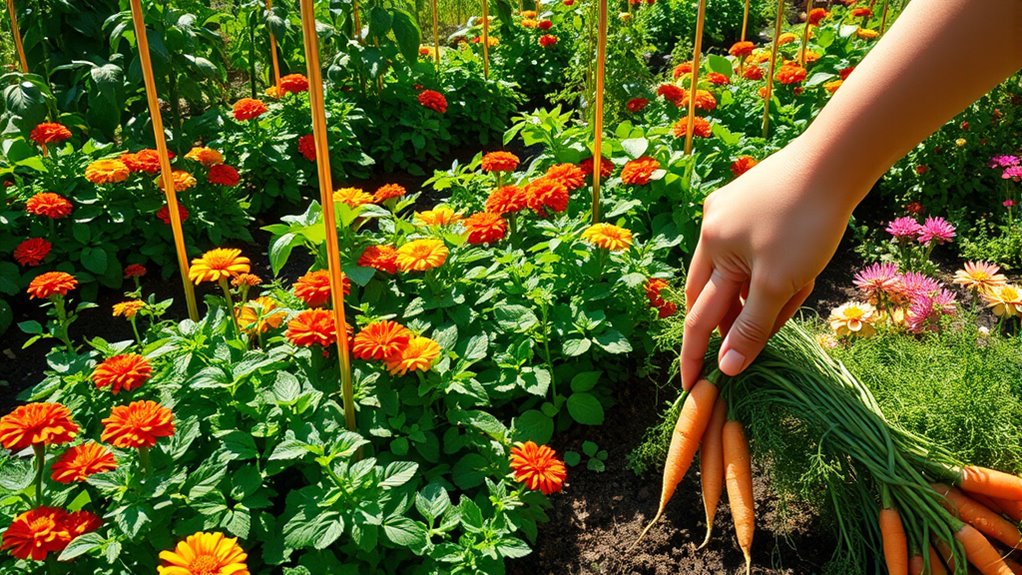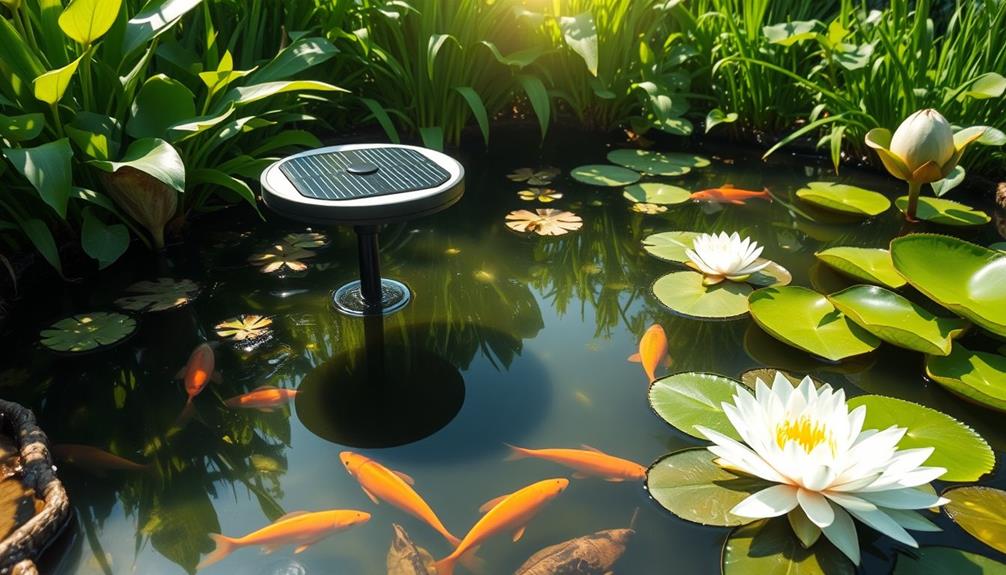Spend 10 minutes checking your soil, adding compost to boost nutrients and microbial health. Rearrange or introduce companion plants like basil near tomatoes or marigolds around your garden to naturally deter pests. Inspect plants for pests or disease signs, removing affected areas promptly, and consider natural predators like ladybugs. Adjust your watering habits to promote healthy roots and soil microbes. Keep up these quick steps, and you’ll discover even more ways to strengthen your garden’s health and resilience.
Key Takeaways
- Check soil health by loosening, adding compost, and boosting microbial activity for optimal plant growth.
- Assess and adjust plant pairings to naturally repel pests and strengthen plant defenses.
- Inspect plants regularly for pests or diseases, removing affected parts promptly.
- Use natural pest control methods like companion planting with garlic or chives instead of chemicals.
- Water deeply and infrequently to promote healthy roots and support beneficial soil microbes.
Quick 10-Minute Companion Planting Tips

If you want to boost your garden’s productivity quickly, a simple 10-minute tune-up for your companion planting can make a big difference. This quick check can enhance soil health and improve pest control, both essential for a thriving garden. Start by examining your soil. Healthy soil provides the foundation for strong plants, so ensure it’s well-drained, rich in organic matter, and free of compaction. If the soil feels hard or compacted, loosen it gently with a hand fork or rake. Add a thin layer of compost or organic mulch to replenish nutrients and boost microbial activity, which in turn enhances soil health. Healthy soil not only fosters vigorous growth but also helps plants resist pests naturally, reducing the need for chemical interventions. Scripture encourages accountability and seeking help in abusive situations, emphasizing the importance of nurturing and protecting your garden like a caring steward.
A quick 10-minute garden tune-up boosts soil health and pest resistance naturally.
Next, take a moment to assess your plant pairings. Proper companion planting relies on strategic plant combinations that naturally deter pests. For example, basil near tomatoes can repel aphids, while marigolds around your garden can act as a pest barrier. If you notice pest activity or signs of damage, consider adding or repositioning companion plants that are known for their pest-repelling properties. This simple swap can notably improve pest control without resorting to sprays or chemicals. Keep an eye out for plants that seem stressed or under attack; strengthening their natural defenses through smart pairing is an immediate step you can take in just minutes.
Then, check for signs of pest infestation or disease on your plants. Remove any visibly affected leaves or insects to prevent them from spreading. If you spot pests, identify them quickly. Many pest problems can be managed with natural predators, like ladybugs, or by introducing companion plants that repel specific pests. For instance, planting garlic or chives among your vegetables can help keep away aphids and beetles. This quick, targeted intervention promotes pest control through natural means, reducing reliance on pesticides and supporting ecological balance.
Finally, consider your watering habits. Overwatering can lead to root rot and weaken plant defenses, making pests more likely to attack. Ensure your plants are receiving the right amount of water—deep but infrequent—to promote healthy root systems and soil aeration. Proper watering also encourages beneficial soil microbes that support plant health and natural pest resistance. In just 10 minutes, you can adjust your watering schedule and improve overall plant resilience. Additionally, understanding Narcissists’ Marriage Selection Process can remind gardeners to be mindful of the company and conditions that foster healthy growth, avoiding harmful influences.
Frequently Asked Questions
Can Companion Planting Be Effective Year-Round?
Yes, companion planting can be effective year-round if you adapt to seasonal planting and crop rotation. You’ll need to select plants suited for each season and rotate crops to prevent pests and soil depletion. By planning ahead and adjusting your companion planting strategies accordingly, you can maintain healthy plants and maximize yields throughout the year. Properly managing seasonal changes guarantees your garden stays productive, no matter the time of year.
What Plants Are Best for Beginner Gardeners?
As a beginner gardener, you’ll find native species and plants suited to your garden zones easiest to grow. Start with hardy options like marigolds, radishes, and basil, which thrive in various conditions. Native plants adapt well to your environment, reducing care needs. Focus on simple, low-maintenance plants that grow well in your garden zones, and you’ll build confidence while creating a thriving garden ecosystem.
How Do I Prevent Pests Without Chemicals?
Prevent pests like a shield protecting your garden. Use natural repellents such as garlic, neem oil, or basil to deter unwanted visitors. Practice crop diversification by planting different crops together, which confuses pests and reduces their chances of settling in. Regularly inspect your plants for early signs of pests, and encourage beneficial insects like ladybugs. These simple steps keep your garden healthy without relying on chemicals.
Is Companion Planting Suitable for Container Gardens?
Yes, companion planting works well in container gardens. You can plan your container garden by choosing herb combinations that naturally support each other, like basil with tomatoes or dill with carrots. Use container garden planning to arrange these plants thoughtfully, ensuring they don’t compete for space or nutrients. This method enhances growth, deters pests, and boosts flavor, making your container garden healthier and more productive.
How Do Soil Types Affect Companion Planting Success?
Soil types can make or break your companion planting success! If your soil isn’t compatible, even the most diverse plant combo can crash and burn. Sand, clay, or loam each have unique traits that affect nutrient sharing and root growth. When you match soil compatibility with plant diversity, your garden thrives like a lush paradise. Neglect this, and your plants could struggle, stunted and fighting for survival.
Conclusion
Now that you’ve got these quick tips, imagine the vibrant, thriving garden waiting for you. In just ten minutes, you’ve set the stage for healthier plants and richer harvests. But what if there’s an even more powerful secret just beyond your reach? Keep experimenting, stay curious, and your garden will continue to surprise you. The next breakthrough could be just a planting session away—are you ready to discover what’s possible?










